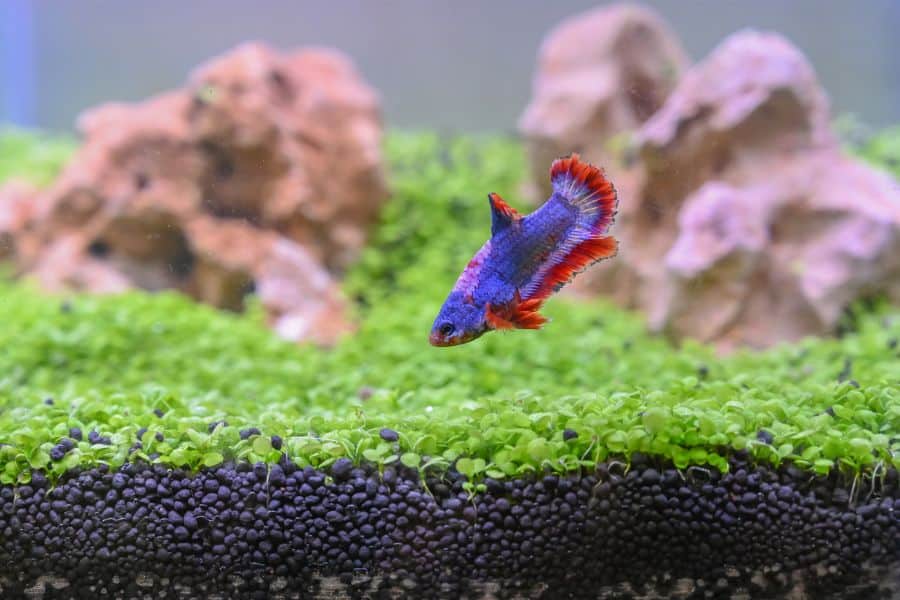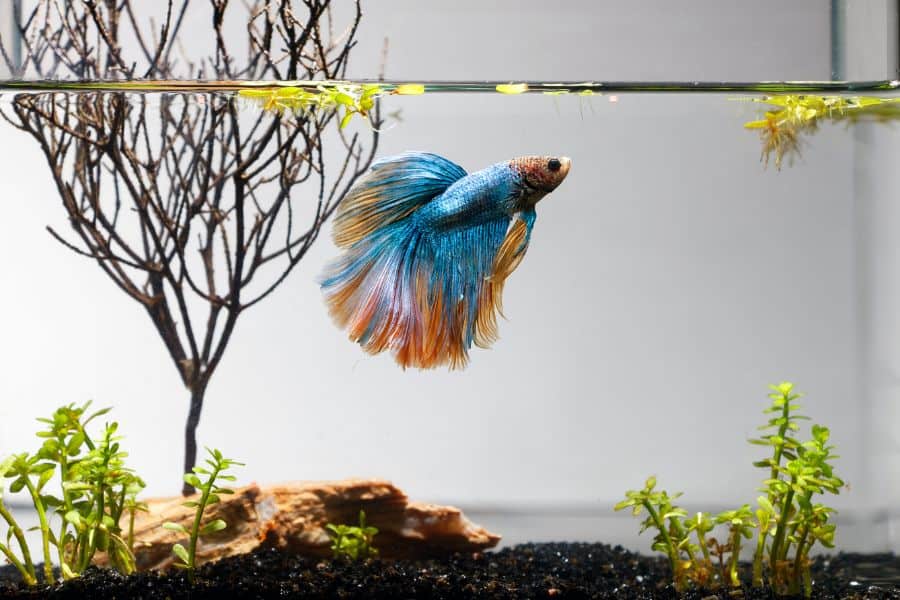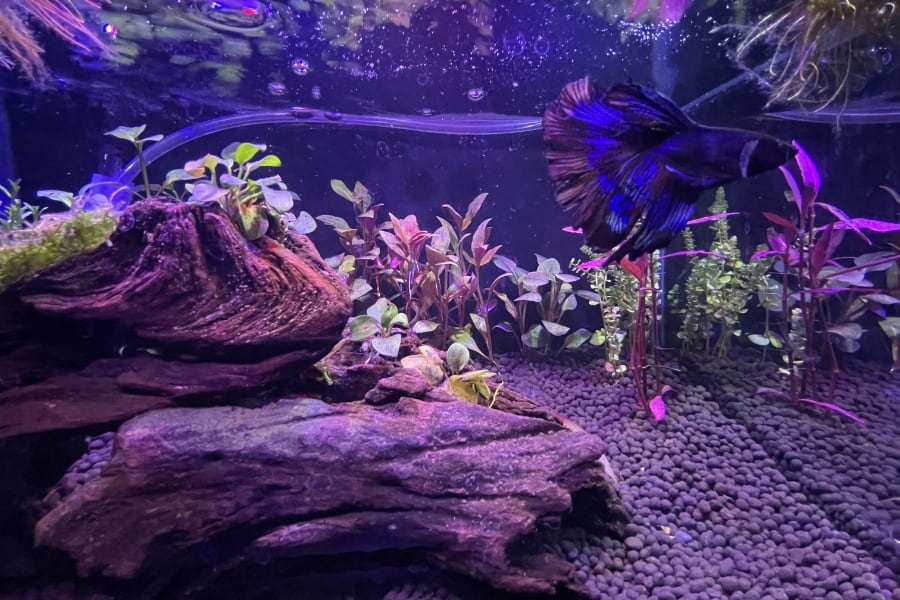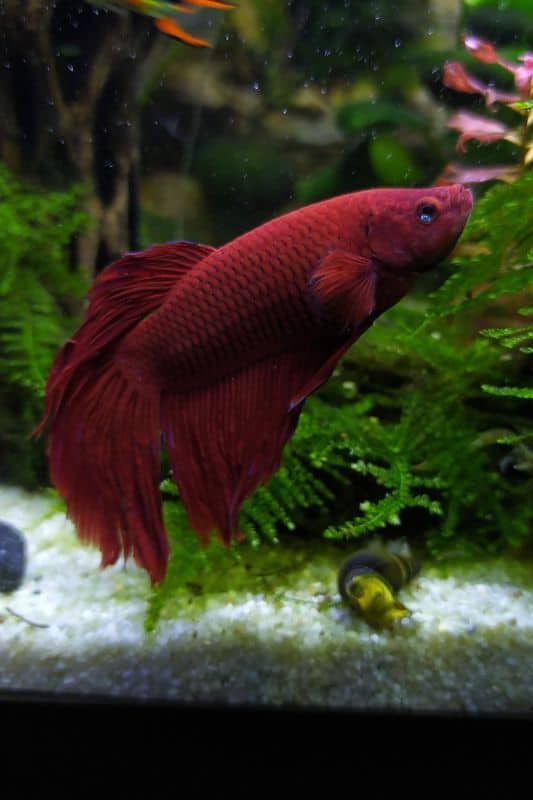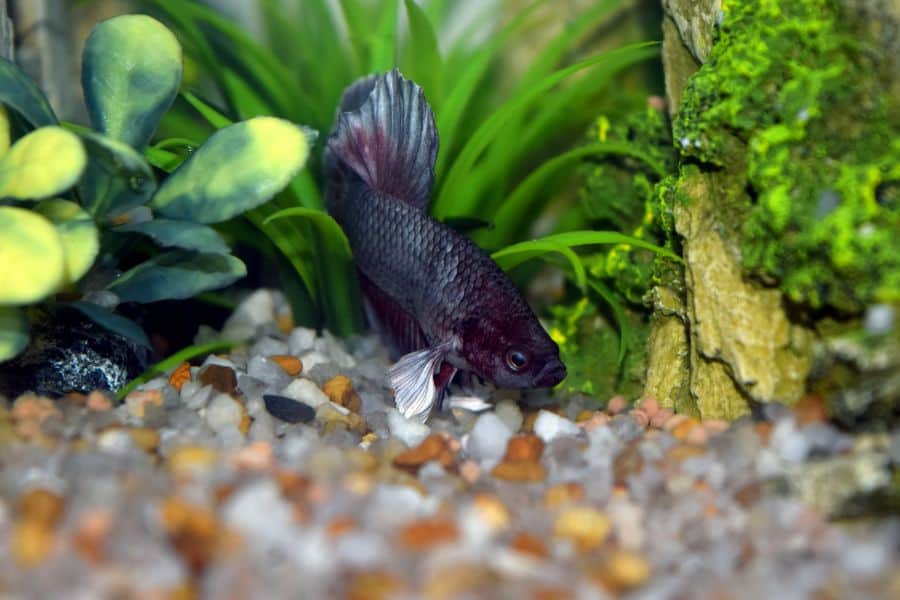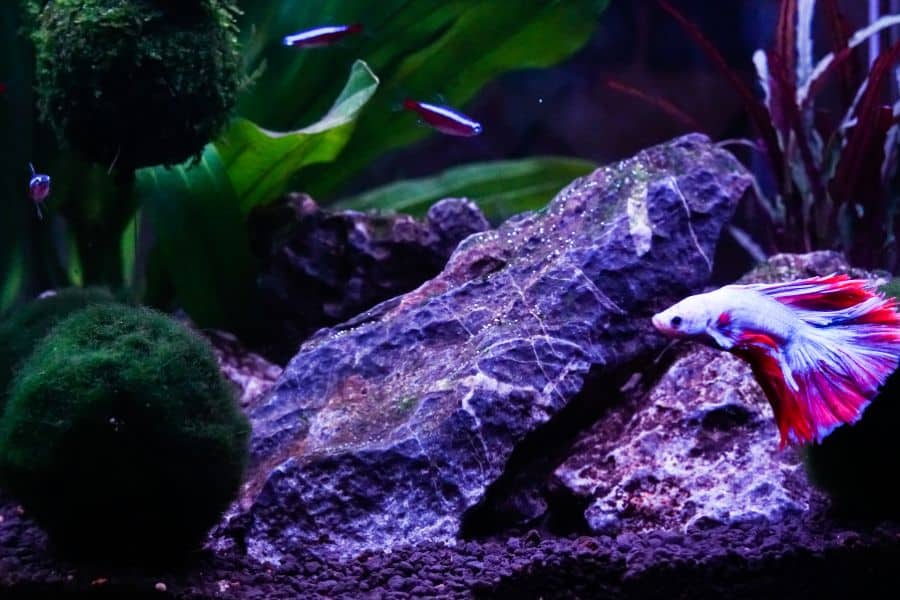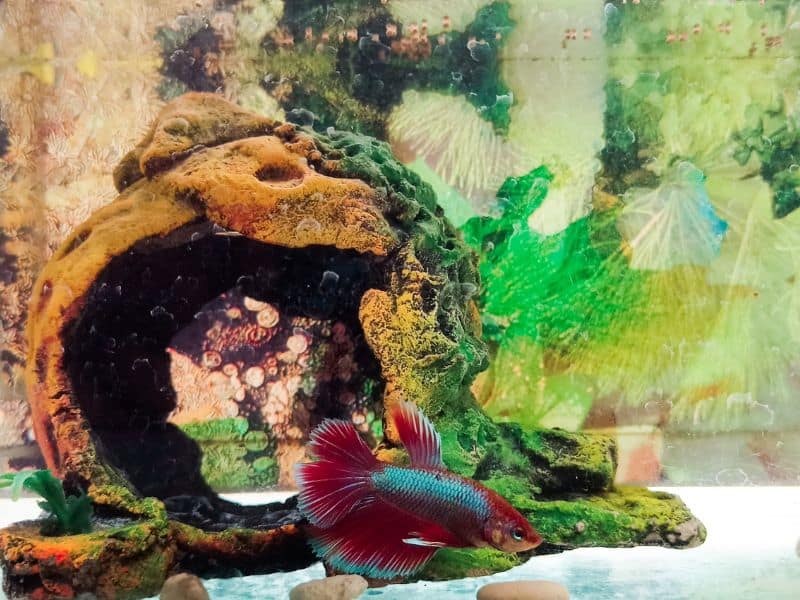Betta fish are arguably some of the most popular aquarium fish of all time. Despite being warm-water species, Betta fish managed to capture the hearts of aquarium owners all over the world.
It doesn’t matter if you live in a cold-weather country or a tropical country – there’s a big likelihood that someone you know owns a Betta or knows someone who owns one. You may even be interested in getting one yourself. After all, they’re super easy to care for, right?
Actually, there are a lot of things that come into play when it comes to properly caring for a Betta fish. One of the most important factors that many overlook is the kind of substrate you choose for your aquarium.
In this article, we’ll discuss the best substrates for Betta fish, so you can make an informed decision when buying substrates for your Betta tank!
Do Betta Fish Need Substrate?
Before we get into the nitty-gritty details of how to choose the best substrate for Betta fish, let’s get one thing out of the way first.
Do Betta fish need substrate in the first place?
The short answer is no. Technically, Betta tanks don’t need to have a substrate.
Betta fish can survive without substrate, and some aquarists have successfully kept Betta tanks with no substrate at all.
That said, keep in mind that this comes with some downsides.
- You won’t be able to add plants that need root systems.
- You’ll need to clean more often because all dirt and debris will be visible.
- You’re reducing the areas where beneficial bacteria can grow.
- The tank will look bare and even uninteresting.
- Some Bettas don’t like seeing their reflection on the floor.
So, while Betta fish may not need substrate in their tank, it does provide some additional benefits that you should take into account.
4 Best Types of Substrates for Betta Fish
With so many different kinds of substrates on the market, it can be difficult to decide which one is best for your Betta fish. Without further ado, here are the five best substrates for Betta fish:
Aqua Soil
Pros:
- Great for planted tanks
- Easy to use for decorating
- Lasts for years
- Additional benefits
Cons:
- More expensive
- Leaches ammonia at first
- Needs to be fully cycled for safety
If you’re thinking of putting live plants in your Betta tank–and let’s be honest, you totally should–then aqua soil is the best substrate option for you.
Aqua soil is a special type of substrate that is chockful of nutrients and minerals – perfect for encouraging the growth of live plants. It can also soften water and help keep your tank’s pH levels at an optimum level, making it a great choice for Betta tanks.
Some premium aqua soil options may also contain added beneficial bacteria, which help speed up the cycling process for new tanks, break down fish waste, and keep your tank healthy.
That said, keep in mind that aqua soil can be quite expensive. All those extra nutrients don’t come at a low cost, and you’ll need to buy more bags if you have a bigger tank.
Additionally, it leaches ammonia when first used, so you need to wait for it to get fully cycled before adding your Betta to the tank. You also need to do lots of water changes in the beginning to prevent ammonia buildup.
Speaking of which, adding water to aqua soil can be a messy, frustrating experience, especially for beginner fish keepers. Ideally, you should add some type of plastic or cover on top of the soil before adding water to prevent the grains from getting squished and turning into mud.
Some Aqua Soil for Betta Tanks
- ADA Amazonia: There are very few aqua soil options on the market that can compare to ADA’s premium aqua soil. This aqua soil is made from natural materials, has a great track record for keeping tanks clean and healthy, and has plenty of added beneficial bacteria. For planted tanks, you can’t go wrong with ADA Amazonia. There’s also an Amazonia Version 2 just in case you want something that’s even more nutritious and with a smaller grain size.
- Aqueon Plant and Shrimp Substrate: As the name suggests, this clay-based aqua soil is specially formulated for shrimp and bottom-feeding fish. With its soft, rounded grains, it’s a great choice for Betta tanks that have tank mates, especially since many of those tank mates would be at the bottom.
- Carib Sea Eco-Complete: This pre-cycled aqua soil has all the nutrients you could possibly need in your tank, such as iron, potassium, and magnesium, among many others. This not only helps keep your water parameters balanced, but it also promotes optimum plant growth while reducing algae growth. It features bimodal grading, which means both small and large grains are present in this soil.
Sand
Pros:
- Cheap for small tanks
- Natural look and feel
- Gentler on your Betta’s delicate fins
- Easy to clean with a special siphon vacuum cleaner
Cons:
- Needs proper maintenance
- May decrease pH levels over time
- Not compatible with underground filtration systems
- Can prevent root systems from growing
Interestingly, the topic of adding sand as a substrate in small tanks is actually a pretty controversial one.
Some aquarists think that sand is too soft for a Betta fish tank. They think that small fish like Bettas may ingest sand, leading to health problems like impaction or constipation. Meanwhile, others believe that sand can actually be beneficial for Betta tanks.
So, is sand good for Betta fish?
Actually, yes, sand is a good substrate choice for Bettas. Sand can provide a naturalistic and, therefore, comfortable environment for your Betta fins.
It looks good aesthetically, and its grains are so small that they won’t damage the fins of your Betta – a common problem associated with gravel substrates.
It’s also easy to clean with a siphon. Due to the size of the sand grains, dirt and debris tend to just sit on top of the surface instead of falling in between the grains. You won’t have to play hide and seek with waste particles.
The biggest problem with sand is that it requires proper maintenance.
Although it’s easy to clean if you have a siphon vacuum, you do have to manually stir it every now and then to prevent anaerobic pockets from forming. These are areas where no oxygen can reach, leading to the growth of toxic bacteria.
Another issue related to this is that sand compacts. If you have plants, they may not be able to grow their root systems well because sand doesn’t leave enough space for the roots to grow. This is why the occasional stirring is absolutely essential if you have sand in a planted tank.
Additionally, sand has a high buffering capacity, meaning that it can slowly decrease the aquarium’s pH levels over time. This is why it’s important to check your tank’s pH levels regularly when using sand as a substrate.
In general, though, as long as you’re using the right type of sand, it’s a safe and great option for Betta tanks.
As long as you’re using the right type of sand, it’s a safe and comfortable substrate for your Betta tank. So make sure you get the correct aquarium-safe sand before you use it.
Some Sand Substrates for Betta Tanks
- Seachem Fluorite Black Sand: Designed for a planted aquarium, this option is a great all-rounder, regardless if you want plants or not. It’s pH-neutral and is not chemically treated, making it very effective in Betta tanks. Aesthetically, it also looks incredibly sleek and modern.
- Carib Sea Super Naturals: True to its name, this substrate provides a natural look to your Betta tank. The grains are soft and pH-neutral, which means they won’t hurt your Betta’s fins or change your water’s natural chemistry. And although it doesn’t contain extra nutrients for plants, it’s also a good substrate for plants.
Gravel
Pros:
- Cost-effective
- Doesn’t shift as much as sand
- Widely available even in local fish stores
Cons:
- Some types may be too rough on your Betta’s fins
- Traps dirt and debris in between
Gravel is another popular substrate choice for Betta fish tanks – and for a good reason. It’s lightweight, not that difficult to clean, and provides a lot of surface area for beneficial bacteria to thrive.
You also won’t have to worry about your Betta fish ingesting gravel since it’s too large for them to swallow. It even makes a great base for plants and other decorations, so you can get creative with your aquarium setup.
Just keep in mind that some gravel substrates may be too rough for your Betta fish’s fins and could cause damage. It’s important to choose smoother variants, like pea gravel. These are round-shaped gravel that won’t hurt your fish’s fins.
Also, depending on the grain size, gravel can sometimes trap dirt in between. You don’t want this to happen because any waste material inside the tank that’s left uncleaned will contribute to the levels of ammonia in the tank.
Gravel Substrates for Betta Tanks
- Seachem Flourite Gravel: This porous, untreated substrate is designed to support the growth of live plants, particularly root feeding ones. The grains are smooth, so even though it’s gravel, you won’t have to worry about hurting your Betta fish’s fins. You can also mix it with other substrates, like sand, to make an ideal environment for your fish.
- Pisces Gunsmoke Aquarium Gravel: Hailing from New Zealand, this river gravel adds a subtle touch to your Betta tank. It’s made from natural materials and has oval grains that are small enough for your Betta to lay on them and not get hurt. It also encourages the growth of beneficial bacteria and can support live plants.
- AquaNatural Diamond Black: Made out of 100% natural quartz, this gravel substrate looks unique from all the other substrates on this list. Its black coloration will make your Betta’s colors – and your plants – pop out. If you’re concerned about your planted tank’s aesthetics, you can’t go wrong with this choice.
Rocks
Pros:
- Looks natural
- Can be used as a base for decorations
- Doesn’t alter the pH
- Can sometimes change the hardness of water
Cons:
- Not all stones are aquarium-safe
- Not compatible with many plants
Natural stones and pebbles are also a decent substrate option for Betta fish tanks.
Usually, we’re talking about river stones, but aquarium-safe stones from other areas of the world can also be used.
The great thing about these types of substrates is that they can provide a stable base for decorations, as well as give your tank an aesthetically pleasing look.
Many of them don’t change the pH levels of your tank, so you can have peace of mind in that regard. In fact, depending on what specific material you’re working with, it may also help adjust the hardness of the water, which can be beneficial if you have very soft or very hard water.
The biggest downside is that not all plants thrive in this type of substrate. If you want a planted tank, you will have to go for specific plants such as Anubias.
Also, some stones may be too sharp and could potentially hurt your fish’s fins, so it’s important to check the type of stone you’re getting before adding them to your tank.
Stone Substrates for Betta Tanks
- Miukada River Rocks: A neutral stone substrate that looks good and won’t change the parameters of your tank. It’s completely safe for aquarium use and looks great with decorations. Plus, the stones have been smoothened before packing, so you don’t have to worry about your Betta’s fins getting snagged.
- Spectrastone Shallow Creek Pebble: This substrate is ideal for Betta tanks due to its neutral pH and relatively small size. In addition, the colors are great at enhancing the color of your decorations and fish. The smooth pebbles have shades of yellow to brown, so they look completely natural.
How to Choose the Best Substrate for Betta Fish
Now that you know all your options, let’s talk about the process of choosing what substrate is best for Betta fish. After all, our suggestions are just that – suggestions – and your choice of substrate ultimately still depends on your specific needs and preferences.
What Substrate Do Betta Fish Have in the Wild?
In the wild, Betta fish typically live in very shallow, slow, or unmoving bodies of water, including rice paddies, peat swamps, and small ponds. These habitats tend to have sandy, muddy, or even silty bottoms.
Technically, this means that sand and mud are substrates that Betta fish are used to.
However, it doesn’t mean they’re the ideal type of substrate for Betta fish.
For instance, not only is mud extraordinarily messy and difficult to keep clean, but it also has a tendency to accumulate toxins over time.
Additionally, silt can be even more problematic as it can easily create dead spots in your Betta tank due to the lack of oxygen.
Luckily, an aquarium is a controlled environment. While it’s completely fine to simulate the kind of substrate that Betta fish have in the wild, we’re also free to use other types of substrates that are more beneficial for them and easier for us to handle.
Factors to Consider When Choosing the Best Substrates for Betta Fish
Now that we know which substrates are best for Betta fish, we can start looking at the other factors that you need to consider when choosing the best substrate.
These include:
- The size of your Betta’s tank
- The type of Betta fish you have
- Whether you plan to keep other species in the same tank
- How often you’re willing and able to clean the substrate
- Your budget
FAQs
Are Marbles Good for Betta Tanks?
Personally, we don’t recommend marbles for Betta tanks. They’re difficult to clean and don’t provide any benefits for Betta fish. However, there are some aquarists who keep their Bettas in tiny tanks of 1-2 gallons that also use marble as a substrate.
Does the Color of The Betta Tank Substrate Matter?
The color of your Betta tank substrate doesn’t really matter, at least to the Betta. If you’re going for a certain aesthetic or theme, feel free to choose the color that you like best.
The most popular – and most natural – colors are white, black, and brown. Some aquarists like white because it shows dirt easier, while others like black because it hides dirt. It really depends on your specific preferences.
How Much Substrate Do I Need for My Betta Tank?
We recommend having at least 1-2 inches of substrate for a small tank and 3-4 inches for a larger tank. Of course, if you want a planted tank, you’ll need a thicker substrate in order to provide enough space for the roots to grow.
One cool trick that many fish keepers use is to create a slope using the substrate and adding plants only to the thickest areas. Not only does this give you more floor space, but it also saves you money on additional substrate.
Read More: Betta Fish Tank Setup: What to Put In?
Conclusion
At the end of the day, the best substrate for Betta fish is one that’s safe, provides them with a comfortable home, and meets their individual needs.
Keep in mind that you don’t have to stick with any of the substrates mentioned in this article, as there are many other options available on the market. Just make sure to do your research and choose the substrate that’s best for both you and your Betta fish!
